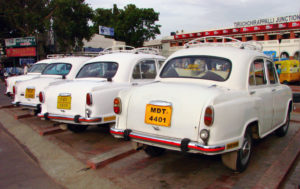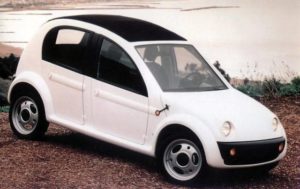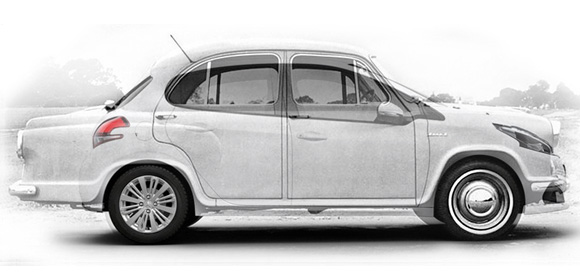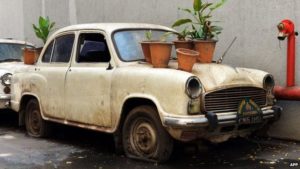February 11, 2017:
Claiming it was purchased for a nominal amount of just $12 million US (£9.6m), CK Birla Group (CBG), the owners of India’s Hindustan Motors announced the sale of its Ambassador car brand to PSA Group Peugeot Citroën.
Hindustan Motors stopped production of the Ambassador in 2014 while citing debt and lack of demand for the vehicle, which was modeled on Britain’s long-defunct Morris Oxford.


“We have sold it for just 800 million rupees but we had already stopped production at the plant nearly three years back. The plant has been closed since then,” the official said.

Last month, CBG had signed a separate agreement with PSA Group to set up two joint ventures with initial production capacity estimates of around 100,000 vehicles per year by 2020.
The move may have been a reactionary one to Renault, who announced on November 3, 2016 that it will invest $100 million to expand vehicle assembly capacity its Ghandara plant in Pakistan by 2018. PSA Group has long been keen to get a foothold in India and was one of the first foreign car makers to enter the country in the mid-1990s when the economy first was liberalized.
PSA Group said on Friday that it had not yet decided which model it will build in India. The staid and conservative early 1960’s looking Ambassador once ruled India’s roads and for years was the only car driven by politicians and senior government officials, but it was muscled out over the years by the entry of more modern vehicles, particularly the SUVs increasingly favoured by senior bureaucrats. The car still remains popular with some taxi drivers, politicians, and tourists looking for nostalgia. Its downfall was as spectacular as its rise – dropping from sales of more than 20,000 cars in the mid-1980s to about 2,000 in 2013-14 when production was suspended.

The car did win plaudits for its spacious interior and sound suspension, which was ideally suited to Indian roads. It was also one of the first diesel cars to appear in India and one of the first to have air conditioning. However the car was also renowned for its idiosyncrasies. The handbrake rarely worked properly – instead spawning a generation of drivers that could easily do hill starts deftly balancing the accelerator and brake. The indicator controls were often mounted in unusual positions, its brakes were notoriously soft and its steering lock was virtually non-existent.
PSA’s concentration on the Asian market for the past 20 years has mainly been in China. We speculated back in the late 1990’s that the company might introduce a very simple car, a contemporary 2CV like vehicle, to that emerging market at the time.

 Chrysler CCV Concept. The CCV project started in the late 90s at pre-Daimler-merger Chrysler, and the project was focused on developing radical new techniques in design and construction with the goal of making a very inexpensive car for developing markets. Chrysler purchased and disasembled a Citroën 2CV. The name chosen for the project is especially telling: it technically stands for Composite Concept Vehicle, referencing the extensive use of plastic composites. The fundamental design of the Chrysler CCV was absolutely, unashamedly, based on the venerable old Citröen 2CV for rugged, cheap basic-transportation. Even the name; 2(C)+V.
Chrysler CCV Concept. The CCV project started in the late 90s at pre-Daimler-merger Chrysler, and the project was focused on developing radical new techniques in design and construction with the goal of making a very inexpensive car for developing markets. Chrysler purchased and disasembled a Citroën 2CV. The name chosen for the project is especially telling: it technically stands for Composite Concept Vehicle, referencing the extensive use of plastic composites. The fundamental design of the Chrysler CCV was absolutely, unashamedly, based on the venerable old Citröen 2CV for rugged, cheap basic-transportation. Even the name; 2(C)+V.
Of course the company instead chose to offer it’s current product line globally with a few minor tweaks for the Chinese, and making the most of what they could from partnership with Dongfeng Motor Corporation, a Chinese state-owned automobile manufacturer. PSA has catered to modern Chinese tastes as its competitors like VW were doing. But unlike VW with a 14% market share, Peugeot and Citroën collectively have attained less than 4% penetration (based on 2015 sales data).
Will that same strategy be applied to the India market? With the Tata Nano and a history of cheaper cars being offered in India, PSA Group might look internally to its cheaper brand, which would now be Citroën, and offer those models as Ambassadors into the market. However given that PSA Group feels that Peugeot is a more recognized brand in the Asian market, it will be interesting to see which one, if either, will be the envoy for the Ambassador brand expense they have incurred.



